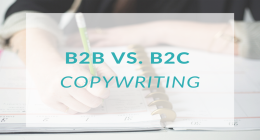If you’re in B2B marketing, you’ve probably already discussed the value of a B2B social media strategy for your business. Here are some common objections you’ve probably thought of:
It’s expensive to maintain and has no impact on the bottom line.
You’re skeptical that customers will even find you there or research you.
Your marketing team is overwhelmed and feels that the best place to save money is social media.
You’re not alone. Finally, social media channels are focused on B2C and consumer products and services. Social media are often where people go to check up on their friends, see what’s going on, and find fun and inspirational things to do. They’re social, not business-oriented. Therefore, social channels value content that is light, fun, or consumer-centric. In other words, story-driven content wins. So is social media valuable for B2B companies?
Our answer is a resounding “yes.” In this article, we’ll explain the business reasons to invest in B2B social media marketing.
Here’s the lowdown:
Social media can be a valuable tool for building your brand and generating demand, which are important at every stage of the customer journey. Social media is a long game. It takes time, consistency, and story-driven social media content for brands to reap the rewards of their efforts.
A cross-platform approach isn’t best for every business. Big brands have the resources and audience to maintain a big social presence. Small businesses can benefit from a more focused approach.
The best content is story-driven. It gives you a reason to follow. It should be fun, helpful and inspiring.
Personal and brand social accounts are like a flywheel. Investing in both will help your business grow.
Let’s dive in. Social Media Business Model
Let’s start with the skeptics. Rand Fishkin, a speaker and author on SEO and marketing, shared a Reddit thread from a user who wrote: “Big brands win on social media because they have brand recognition, but for brands with smaller budgets, social media should never be a core strategy.”
Big brands in the B2C or B2B space, such as Apple, Nike, Microsoft, Slack, and HubSpot, have a huge influence on social media. After all, they have invested years into building their brand and building a loyal customer base. Small businesses may be hesitant to spend their budget on talent to handle social media full time and continually create content. Big, established brands don’t have to worry about this. So should B2B companies invest in social media as part of their digital marketing strategy? One user responded: “The problem is when low-budget brands try to act like brands with big budgets. That’s not your game. You need to be more flexible and lean.”
Today, B2B social media is on a more level playing field than ever before. Brands big and small can leverage the power of social media. Social media is a cost-effective channel with a potential audience of over 3.6 billion people, more than 50% of the world’s population.
With the right strategy, the right tools, and more importantly, the right team, even a small company can look like a big one. But before that happens, marketing teams need to re-set expectations. While social media can help increase sales when used strategically for direct marketing and lead generation, it’s also a great marketing tool for building brand awareness. That should be their primary objective.
Brand first, then demand. Brand building is the flywheel of content, so it drives the most demand. A strong content strategy grows your brand, which in turn creates demand. You may host a blog on your website, but even with SEO and keyword optimization, your content won’t resonate if you don’t promote it and engage with your audience. One of the best places to do this is through social media platforms.
Growth Requires Persistence and Patience
Building a strong brand presence takes time. Marketers can get obsessed with quantifying leads and direct impact. In most cases, social media doesn’t gain customers immediately. But with discipline, patience, and a focus on content that’s useful to customers, building your brand on social media can have a positive impact. Here are the numbers:
54% of social media browsers use social media to research products. (Global Web Index)
80% of B2B leads on social media come from LinkedIn. (LinkedIn)
Social media is the number one source of inspiration for consumers to buy, with 37% of consumers getting inspiration to buy through this channel. (PWC)
Social media is the most relevant advertising channel for 50% of Gen Z and 42% of millennials. (Adobe)
The bottom line is new sales. B2B social media efforts take time to see results. It’s like SEO: it takes time for your brand to see the benefits of your efforts. It’s easy to fall into the trap of wanting instant results. This is especially true when you need to track metrics for your company’s executive team and demonstrate the ROI of your social media efforts. Perhaps the best approach is described by entrepreneur Gary Vaynerchuk in his book Jab, Jab, Jab, the Right Hook: A “jab” is a compelling, helpful, and inspirational piece of content on social media. A “right hook” focuses on demand generation and only works if successful microcontent (“jabs”) are shared over time. Investing in hundreds of microcontent pieces that deliver marginal returns will ultimately build your brand and form a community of loyal customers. Just as interest allows money to grow over time, so too will social media impact grow with consistent, high-quality content backed by a strong B2B social media strategy.
The key is to establish short-, mid-, and long-term KPIs that relate to sales and show positive growth month over month. For example, a good indicator of short-term impact could be website traffic from social media. Over time, more traffic = more sales (if your site is optimized for conversions).
A good mid-term KPI will be tied to sales. You can set up conversion goals in Google Analytics to track conversions from social media. And good long-term KPIs should focus on branding metrics like impressions and engagement, tracked using tools like Google Analytics in addition to social media management tools like Sprout Social, Hootsuite, and Buffer. Building an audience takes consistency and patience. But if you focus on brand building first and demand generation second, it’s a worthwhile investment.
Story-driven content wins
The best brands share compelling stories. Let’s be honest, B2B creative and social strategies are years behind B2C brands. They only post content that’s dry, uninspired, and unhelpful. This type of approach leads to low engagement and doesn’t impact the bottom line. So B2B marketers need to pivot. They need to focus on sharing stories about their customers, employees, and communities from a mission perspective, not a product or service perspective.
The formula is simple: get people to care. As filmmaker Andrew Stanton said in his 2012 TED Talk, “Just see if it interests me emotionally, intellectually, and aesthetically.” “We all know what it feels like when you don’t care about anything. You’ve been watching hundreds of TV channels, hopping from channel to channel, and suddenly you stop on one channel. You’re already half way there, but something has grabbed you, captivated you, interested you. This isn’t by chance, it’s by design.”
Why can’t B2B content be as entertaining as Ted Lasso, as inspirational as The Pursuit of Happyness, and as educational as Mythbusters? The best content on social media falls into three categories:
Entertainment “I need to laugh, cry, or be moved”
Helpful “I need to learn something”
Inspirational “I need ideas”
Focus your content on your customers, not your company. The bar is low for B2B content on social media right now. Nobody likes to be sold on, but we all love a good story. As Gary V puts it, “You also need to encourage the horse to drink.”
Is a multi-platform approach best for you? You may want to have a presence on every social platform. It’s easy to get FOMO or try to keep up by copying your competitors or other brands you admire. But every channel is different, and every business has a different audience.
For example, LinkedIn is a great B2B platform but isn’t perfect for every business. TikTok, Facebook and Instagram are more consumer-focused but with the right creative approach they can work for your brand. Consider the content you’re creating, your target audience and what resources you have at your disposal to find the right social media platform for your business.
Here are some key questions to help you:
Who are your buyer personas and what technology do they use? What are the strengths and weaknesses of your content?
What resources should you provide for this? How do your personas use each platform? And how does this influence their purchasing decisions? What goals is your company pursuing on social media? What field do you work in? What creative resources do you have available to you? It’s important to understand how to tell your story in the right way for each platform. For example, an Instagram post allows you to swipe through your content to post multiple photos or videos. Other platforms may limit the number of photos shown in your feed or display your photos in other ways. The best creative content — content that gets attention — is optimized for native publishing on a specific channel.
Which works better: personal or brand accounts? People want to do business with other people, so posting regularly on your personal accounts (especially LinkedIn or Twitter) is a great way to increase awareness and interest in your business. It’s also a force multiplier: the more people in your organization commit to posting, the more visible you’ll be. More accounts mean more unique impressions. Investing in maintaining personal accounts pays off even more over time than a single brand account. This requires training, trust, and a true team strategy.
Your best advocates are your employees, so empowering them and incorporating them into your social media strategy will help you build a strong brand on social media. B2B companies that are successful on social media encourage their employees to post on their own accounts to grow their own brand, in addition to, not instead of, social media posts from brand accounts. (Gong, G2, Terminus, Drift are good examples)
However, there is still value in maintaining a brand account. It’s a ticker for news and information about your team and products/services. And it’s another touchpoint to build trust throughout the buyer’s journey. You can never control your brand, but you can manage it. Your brand’s social media accounts are a powerful management tool.
The best story wins
The best story wins on social media. They generate the most impressions, the most engagement, and the most traffic. And these interactions continue over time, helping grow a company’s brand and bottom line. Social media isn’t just for B2C companies; it’s a powerful tool for B2B marketers who have the patience to invest the time and the creativity to keep people interested.









